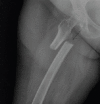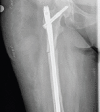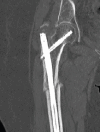Atypical Femoral Fracture in a Patient without Bisphosphonate or Denosumab Exposure-A Case Report
- PMID: 35415098
- PMCID: PMC8930293
- DOI: 10.13107/jocr.2021.v11.i10.2450
Atypical Femoral Fracture in a Patient without Bisphosphonate or Denosumab Exposure-A Case Report
Abstract
Introduction: Atypical femoral fractures (AFF) are associated with the use of bisphosphonates (BPs) or denosumab. However, few cases that meet the characteristics of these fractures, as established by the American Society of Bone and Mineral Research, have occurred in patients who have never used antiresorptive drugs.
Case report: We report a case of AFF in a 67-year-old woman who had never used antiresorptive medications. The history and comorbidities of the patient, the characteristics of the fracture, and the subsequent treatment are presented.
Conclusion: AFFs may occur even in patients who have never been exposed to BPs or denosumab. The absence of antiresorptive osteoporosis therapy and the lack of radiographic focal periosteal reaction in the lateral femoral cortex, as in our case, can make it difficult to detect and prevent the disorder. Prolonged use of proton pump inhibitors and Vitamin D deficiency-related osteomalacia may contribute to the occurrence of these fractures. Further studies are required to accurately understand all inciting factors contributing to the development of AFFs.
Keywords: Atypical femoral fractures; antiresorptive drugs; bisphosphonates; denosumab; subtrochanteric fractures.
Copyright: © Indian Orthopaedic Research Group.
Conflict of interest statement
Conflict of Interest: Nil
Figures






Similar articles
-
Atypical subtrochanteric and diaphyseal femoral fractures: second report of a task force of the American Society for Bone and Mineral Research.J Bone Miner Res. 2014 Jan;29(1):1-23. doi: 10.1002/jbmr.1998. Epub 2013 Oct 1. J Bone Miner Res. 2014. PMID: 23712442 Review.
-
Incidence of Atypical Femoral Fractures in Patients on Osteoporosis Therapy-A Registry-Based Cohort Study.JBMR Plus. 2022 Sep 22;6(10):e10681. doi: 10.1002/jbm4.10681. eCollection 2022 Oct. JBMR Plus. 2022. PMID: 36248270 Free PMC article.
-
A case of an unusual subtrochanteric fracture in a patient receiving denosumab.Endocr Pract. 2013 May-Jun;19(3):e64-8. doi: 10.4158/EP12367.CR. Endocr Pract. 2013. PMID: 23337161
-
Bilateral Atypical Femoral Fracture in a Bisphosphonate-Naïve Patient with Prior Long-Term Denosumab Therapy: A Case Report of the Management Strategy and a Literature Review.J Clin Med. 2024 May 9;13(10):2785. doi: 10.3390/jcm13102785. J Clin Med. 2024. PMID: 38792327 Free PMC article.
-
A proposal for an atypical femur fracture treatment and prevention clinical practice guideline.Osteoporos Int. 2018 Jun;29(6):1277-1283. doi: 10.1007/s00198-018-4506-9. Epub 2018 Apr 19. Osteoporos Int. 2018. PMID: 29675745 Review.
Cited by
-
Characteristics of femur morphology and proximal femur bone mineral density in Japanese females with bisphosphonate-related atypical femur fractures.Skeletal Radiol. 2025 Jul;54(7):1503-1510. doi: 10.1007/s00256-024-04857-3. Epub 2024 Dec 22. Skeletal Radiol. 2025. PMID: 39710724
References
-
- Shane E, Burr D, Abrahamsen B, Adler RA, Brown TD, Cheung AM, et al. Atypical subtrochanteric and diaphyseal femoral fractures:Second report of a task force of the American society for bone and mineral research. J Bone Miner Res. 2014;29:1–23. - PubMed
-
- Tan S, Koh S, Goh S, Howe T. Atypical femoral stress fractures in bisphosphonate-free patients. Osteoporos Int. 2011;22:2211–2. - PubMed
-
- Szolomayer LK, Ibe IK, Lindskog DM. Bilateral atypical femur fractures without bisphosphonate exposure. Skeletal Radiol. 2017;46:241–7. - PubMed
-
- Odvina CV, Zerwekh JE, Rao DS, Maalouf N, Gottschalk FA, Pak CY. Severely suppressed bone turnover:A potential complication of alendronate therapy. J Clin Endocrinol Metab. 2005;90:1294–301. - PubMed
Publication types
LinkOut - more resources
Full Text Sources
